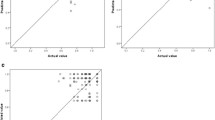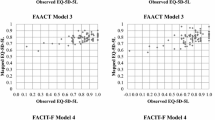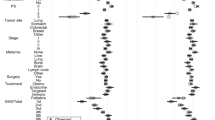Abstract
Background
This study sought to improve the predicative performance and goodness-of-fit of mapping models, as part of indirect valuation, by introducing cubic spline smoothing to map a group of health-related quality of life (HRQOL) measures onto a preference-based measure.
Methods
This study was a secondary analysis of a cross-sectional health survey data assessing the HRQOL for patients with colorectal neoplasms. Mapping functions of condition-specific functional assessment of cancer therapy—colorectal (FACT-C) onto preference-based SF-6D measure were developed using a dataset of 553 Chinese subjects with different stages of colorectal neoplasm. The missing values of FACT-C were imputed using multiple imputation. Then three widely applicable models (ordinary least square (OLS), Tobit and two-part models) were employed for the mapping function after applying the cubic spline smoothing on the data. For the evaluation of the effectiveness of cubic spline smoothing and multiple imputation, the goodness-of-fit and prediction performance of each model were compared.
Results
Analyses showed that the models fitted with transformed data from cubic spline smoothing offered better performance in goodness-of-fit and prediction than the models fitted with the original data. The values of \(R^2\) were improved by over 10 %, and the root mean square error and the mean absolute error were both reduced. The best goodness-of-fit and performance were achieved by OLS model using transformed data from cubic spline smoothing.
Conclusions
Cubic spline smoothing and multiple imputation were recommended for the mapping of HRQOL measures onto the preference-based measure. Among the three mapping models, the simple-to-use OLS model had the best performance.



Similar content being viewed by others
References
National Institute for Health and Care Excellence (NICE). (2013). Guide to the methods of technology appraisal. http://publications.nice.org.uk/pmg9
Brazier, J. E., Yang, Y., Tsuchiya, A., & Rowen, D. L. (2010). A review of studies mapping (or cross walking) non-preference based measures of health to generic preference-based measures. The European Journal of Health Economics, 11(2), 215–225.
Mortimer, D., & Segal, L. (2008). Comparing the incomparable? A systematic review of competing techniques for converting descriptive measures of health status into QALY-weights. Medical Decision Making, 28(1), 66–89.
Wong, C. K., Lam, C. L., Law, W. L., Poon, J. T., Kwong, D. L., Tsang, J., et al. (2013). Condition-specific measure was more responsive than generic measure in colorectal cancer: All but social domains. Journal of Clinical Epidemiology, 5, 557–565.
Wong, C. K., Lam, C. L., Rowen, D., McGhee, S. M., Ma, K. P., Law, W. L., et al. (2012). Mapping the functional assessment of cancer therapy-general or -colorectal to SF-6D in Chinese patients with colorectal neoplasm. Value in Health, 15(3), 495–503.
Edge, S. B., & Compton, C. C. (2010). The American joint committee on cancer: The 7th edition of the AJCC cancer staging manual and the future of TNM. Annals of Surgical Oncology, 17(6), 1471–1474.
Wong, C. K., Lam, C. L., Poon, J. T., McGhee, S. M., Law, W. L., Kwong, D. L., et al. (2012). Direct medical costs of care for Chinese patients with colorectal neoplasia: A health care service provider perspective. Journal of Evaluation in Clinical Practice, 18(6), 1203–1210.
Wong, C. K., Lam, C. L., Law, W. L., Poon, J. T., Chan, P., Kwong, D. L., et al. (2012). Validity and reliability study on traditional Chinese FACT-C in Chinese patients with colorectal neoplasm. Journal of Evaluation in Clinical Practice, 18(6), 1186–1195.
Wong, C. K., Lam, C. L., Poon, J. T., & Kwong, D. L. (2013). Clinical correlates of health preference and generic health-related quality of life in patients with colorectal neoplasms. PloS One, 8(3), e58341.
Wong, C. K. H., Lam, C. L., Wan, Y., & Rowen, D. (2013). Predicting SF-6D from the European Organization for Treatment and Research of Cancer Quality of Life Questionnaire Scores in Patients with Colorectal Cancer. Value in Health, 16(2), 373–384.
Wong, C. K., Lam, C. L., Mulhern, B., Law, W. L., Poon, J. T., Kwong, D. L., et al. (2013). Measurement invariance of the functional assessment of cancer therapy colorectal quality-of-life instrument among modes of administration. Quality of Life Research, 22(6), 1415–1426.
Wong, C. K., Mulhern, B., Wan, Y. F., & Lam, C. L. (2014). Responsiveness was similar between direct and mapped SF-6D in colorectal cancer patients who declined. Journal of Clinical Epidemiology, 67(2), 219–227.
Webster, K., Cella, D., & Yost, K. (2003). The functional assessment of chronic illness therapy (FACIT) measurement system: Properties, applications, and interpretation. Health and Quality of Life Outcomes, 1(1), 79.
Lam, C. L., Brazier, J., & McGhee, S. M. (2008). Valuation of the SF-6D health states is feasible, acceptable, reliable, and valid in a Chinese population. Value in Health, 11(2), 295–303.
McGhee, S. M., Brazier, J., Lam, C. L., Chin, W. L., Chau, J., Cheung, A., et al. (2011). Quality-adjusted life years: Population-specific measurement of the quality component. Hong Kong Medical Journal, 17(6 Suppl. 6), 17.
Cella, D. (1997). FACIT manual: Manual of the functional assessment of chronic illness therapy (FACIT) measurement system. (4th ed.). Center on Outcomes, Research and Education.
Brand J. P. (1999) Development, implementation and evaluation of multiple imputation strategies for the statistical analysis of incomplete data sets. Rotterdam: Erasmus University
Van Buuren, S., Brand, J. P., Groothuis-Oudshoorn, C., & Rubin, D. B. (2006). Fully conditional specification in multivariate imputation. Journal of Statistical Computation and Simulation, 76(12), 1049–1064.
Durrleman, S., & Simon, R. (1989). Flexible regression models with cubic splines. Statistics in Medicine, 8(5), 551–561.
Poirier, D. J. (1973). Piecewise regression using cubic splines. Journal of the American Statistical Association, 68(343), 515–524.
Austin, P. C., Escobar, M., & Kopec, J. A. (2000). The use of the Tobit model for analyzing measures of health status. Quality of Life Research, 9(8), 901–910.
Huang, I., Frangakis, C., Atkinson, M. J., Willke, R. J., Leite, W. L., Vogel, W. B., et al. (2008). Addressing ceiling effects in health status measures: A comparison of techniques applied to measures for people with HIV disease. Health Services Research, 43(1p1), 327–339.
Akaike, H. (1974). A new look at the statistical model identification. IEEE Transactions on Automatic Control, 19(6), 716–723.
Schwarz, G. (1978). Estimating the dimension of a model. The Annals of Statistics, 6(2), 461–464.
Buuren, S., & Groothuis-Oudshoorn, K. (2011). MICE: Multivariate imputation by chained equations in R. Journal of Statistical Software., 45(3), 1–67
Schafer, J. L. (1999). Multiple imputation: A primer. Statistical Methods in Medical Research, 8(1), 3–15.
Austin, P. C. (2002). A comparison of methods for analyzing health-related quality-of-life measures. Value in Health, 5(4), 329–337.
Pullenayegum, E. M., Tarride, J. E., Xie, F., Goeree, R., Gerstein, H. C., & O’Reilly, D. (2010). Analysis of health utility data when some subjects attain the upper bound of 1: Are Tobit and CLAD models appropriate? Value in Health, 13(4), 487–494.
Acknowledgments
We thank Ms. Mansy Sham and Dr. Lei Yang for helping with proofreading and editing the manuscript. Financial support for this study was provided in part by Small Project Funding (Project code 200907176135) from CRCG of the University of Hong Kong and Health and Health Service Research Fund (HHSRF #08090851) of Food and Health Bureau, HKSAR. The funding agreement ensured the authors independence in designing the study, interpreting the data, writing and publishing the report.
Author information
Authors and Affiliations
Corresponding author
Rights and permissions
About this article
Cite this article
Yang, Y., Wong, M.Y., Lam, C.L.K. et al. Improving the mapping of condition-specific health-related quality of life onto SF-6D score. Qual Life Res 23, 2343–2353 (2014). https://doi.org/10.1007/s11136-014-0668-x
Accepted:
Published:
Issue Date:
DOI: https://doi.org/10.1007/s11136-014-0668-x




